The city of Xanthi, seat of a metropolitan and the prosperous capital (ca 40,000) of the nome of Xanthi, stands at the opening of the narrow upper valley of the Kosinthos. The city is linked by bus and train with Athens, Thessaloniki and all major cities of Greece. 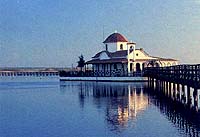 The airport of Chrissoupolis (almost in the middle between Kavala and Xanthi) provides the air services to Xanthi. The city of Xanthi hosts the Faculty of Engineering of the Democritus University of Thrace presently composed of two Departments, the Department of Electrical and Computer Engineering and the Department of Civil Engineering. Starting in fall 1995 the Department of Environmental Engineering is planned to become the third Department in the Faculty of Engineering.The main attraction is the beautiful traditional houses of Old Xanthi which cluster on the hillside to the N of the modern town and below the Byzantine Kastro (sections of fortification visible), which was built to defend the defile from Bulgar incursions. There is a Folk Museum in Odos Antika, containing local customs, traditional implements, etc.
The airport of Chrissoupolis (almost in the middle between Kavala and Xanthi) provides the air services to Xanthi. The city of Xanthi hosts the Faculty of Engineering of the Democritus University of Thrace presently composed of two Departments, the Department of Electrical and Computer Engineering and the Department of Civil Engineering. Starting in fall 1995 the Department of Environmental Engineering is planned to become the third Department in the Faculty of Engineering.The main attraction is the beautiful traditional houses of Old Xanthi which cluster on the hillside to the N of the modern town and below the Byzantine Kastro (sections of fortification visible), which was built to defend the defile from Bulgar incursions. There is a Folk Museum in Odos Antika, containing local customs, traditional implements, etc.
The Cathedral has a collection of icons, manuscripts and church plate. On the higher slopes are some monastries, one of which, the Moni Megiston Taxiarchon, houses the Ecclesiastical College of Xanthi. Byzantine Xanthea grew up below the Kastro.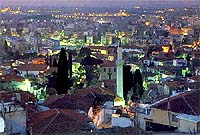 Under the Turks a mere summer resort, Xanthi has, since the coming of the railway, superseded Yenisea as the centre of the fine tobacco growing area. A brand of cigarettes (kiretsiler), obtainable only locally, is much prized. The lower town has been considerably rebuilt in recent years, but apart from sections of Byzantine structures, there are some delightful streets of old low buildings with small slopes, cafes, etc.
Under the Turks a mere summer resort, Xanthi has, since the coming of the railway, superseded Yenisea as the centre of the fine tobacco growing area. A brand of cigarettes (kiretsiler), obtainable only locally, is much prized. The lower town has been considerably rebuilt in recent years, but apart from sections of Byzantine structures, there are some delightful streets of old low buildings with small slopes, cafes, etc.
19km from Xanthi there is the modern village of Abdera. Continuing from the village, just before reaching the sea, there is a sign (left) to the Archaelogical Site and the road leads in a few metres to the remains of ancient Abdera, a city traditionally founded by Hercules on the spot where Abderos was killed by Diomede's horses, but in fact colonized ca 656 BC from Klazomenai. Refounded ca 500 BC by refugees from a Persian occupation of Teos (SW of Smyrna), it became a prominent member of the Delian League and famous for the beauty of its coinage.
Democritus, the 5C philosopher who expounded an atomic theory, Protagoras (ca 481-411), the first of the Sophists, and Anaxarchos, the counsellor of Alexander the Great, were all born here, but despite the celebrity of its school of philosophy, the inhabitants generally were proverbial for their dullness. Hippocrates and Juvenal inveigh against its sickly air. Abdera shared the fortunes of Macedonia and, despite a sack in 170 BC by an over-zealous general, remained nominally free of Rome down to Imperial times, when the city apparently succumbled to its climate. The site continued important in the Early Christian and Byzantine periods when a fortress (Polystylon) was built on the Classical acropolis. Roads connected Polystylon with Xanthea and Peritheorion. It is known to have been the seat of a bishop in the 9C.
 The airport of Chrissoupolis (almost in the middle between Kavala and Xanthi) provides the air services to Xanthi. The city of Xanthi hosts the Faculty of Engineering of the Democritus University of Thrace presently composed of two Departments, the Department of Electrical and Computer Engineering and the Department of Civil Engineering. Starting in fall 1995 the Department of Environmental Engineering is planned to become the third Department in the Faculty of Engineering.The main attraction is the beautiful traditional houses of Old Xanthi which cluster on the hillside to the N of the modern town and below the Byzantine Kastro (sections of fortification visible), which was built to defend the defile from Bulgar incursions. There is a Folk Museum in Odos Antika, containing local customs, traditional implements, etc.
The airport of Chrissoupolis (almost in the middle between Kavala and Xanthi) provides the air services to Xanthi. The city of Xanthi hosts the Faculty of Engineering of the Democritus University of Thrace presently composed of two Departments, the Department of Electrical and Computer Engineering and the Department of Civil Engineering. Starting in fall 1995 the Department of Environmental Engineering is planned to become the third Department in the Faculty of Engineering.The main attraction is the beautiful traditional houses of Old Xanthi which cluster on the hillside to the N of the modern town and below the Byzantine Kastro (sections of fortification visible), which was built to defend the defile from Bulgar incursions. There is a Folk Museum in Odos Antika, containing local customs, traditional implements, etc.The Cathedral has a collection of icons, manuscripts and church plate. On the higher slopes are some monastries, one of which, the Moni Megiston Taxiarchon, houses the Ecclesiastical College of Xanthi. Byzantine Xanthea grew up below the Kastro.
 Under the Turks a mere summer resort, Xanthi has, since the coming of the railway, superseded Yenisea as the centre of the fine tobacco growing area. A brand of cigarettes (kiretsiler), obtainable only locally, is much prized. The lower town has been considerably rebuilt in recent years, but apart from sections of Byzantine structures, there are some delightful streets of old low buildings with small slopes, cafes, etc.
Under the Turks a mere summer resort, Xanthi has, since the coming of the railway, superseded Yenisea as the centre of the fine tobacco growing area. A brand of cigarettes (kiretsiler), obtainable only locally, is much prized. The lower town has been considerably rebuilt in recent years, but apart from sections of Byzantine structures, there are some delightful streets of old low buildings with small slopes, cafes, etc. 19km from Xanthi there is the modern village of Abdera. Continuing from the village, just before reaching the sea, there is a sign (left) to the Archaelogical Site and the road leads in a few metres to the remains of ancient Abdera, a city traditionally founded by Hercules on the spot where Abderos was killed by Diomede's horses, but in fact colonized ca 656 BC from Klazomenai. Refounded ca 500 BC by refugees from a Persian occupation of Teos (SW of Smyrna), it became a prominent member of the Delian League and famous for the beauty of its coinage.
Democritus, the 5C philosopher who expounded an atomic theory, Protagoras (ca 481-411), the first of the Sophists, and Anaxarchos, the counsellor of Alexander the Great, were all born here, but despite the celebrity of its school of philosophy, the inhabitants generally were proverbial for their dullness. Hippocrates and Juvenal inveigh against its sickly air. Abdera shared the fortunes of Macedonia and, despite a sack in 170 BC by an over-zealous general, remained nominally free of Rome down to Imperial times, when the city apparently succumbled to its climate. The site continued important in the Early Christian and Byzantine periods when a fortress (Polystylon) was built on the Classical acropolis. Roads connected Polystylon with Xanthea and Peritheorion. It is known to have been the seat of a bishop in the 9C.
Dasochori (Kotza Orman Forest)
Nestos river is the natural boundary between Macedonia and Thrace. It has its sources in Bulgaria.
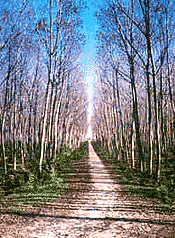 After crossing deep valleys and gorges in the mountains between Mt Orvelos and Mt Rodopi, it debouches into the plains and the sea, opposite the island of Thassos. Its banks from Toxotes to the sea (length: 27km, width:3-7 km) used to be the centre of the most beautiful forest in Europe: Kotza Orman (the words mean "large or legendary forest" in Turkish).
After crossing deep valleys and gorges in the mountains between Mt Orvelos and Mt Rodopi, it debouches into the plains and the sea, opposite the island of Thassos. Its banks from Toxotes to the sea (length: 27km, width:3-7 km) used to be the centre of the most beautiful forest in Europe: Kotza Orman (the words mean "large or legendary forest" in Turkish).
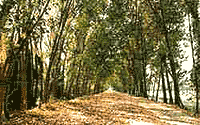 This forest covered an area of 130.000 square metres. It is very important for its vegetation and fauna. Some of the trees found here are poplars, ashes, wych-elms, oaks, bar elders. This forest was a refuge for many wild animals (such as wild boars, wolves, lynxes, otters, badgers, foxes hares and roe deer) and all the birds passing from or living in the area.
This forest covered an area of 130.000 square metres. It is very important for its vegetation and fauna. Some of the trees found here are poplars, ashes, wych-elms, oaks, bar elders. This forest was a refuge for many wild animals (such as wild boars, wolves, lynxes, otters, badgers, foxes hares and roe deer) and all the birds passing from or living in the area.
Kotza Orman is indispensable for the people living nearby. It is a source of timber and a pastureland for the animals of 33 villages. From February to April and during the summer months it is a wonderful habitat for bees. One of the most impressive trees is the ash, well known all over the world for its precious wood. Another tree that is rare in Greece and abundant in Kotza Orman is the black alder.
The big forest, a part of which belongs to the perfecture of Xanthi, could definitely become a National Park, accessible both from the sea and the land.
 After crossing deep valleys and gorges in the mountains between Mt Orvelos and Mt Rodopi, it debouches into the plains and the sea, opposite the island of Thassos. Its banks from Toxotes to the sea (length: 27km, width:3-7 km) used to be the centre of the most beautiful forest in Europe: Kotza Orman (the words mean "large or legendary forest" in Turkish).
After crossing deep valleys and gorges in the mountains between Mt Orvelos and Mt Rodopi, it debouches into the plains and the sea, opposite the island of Thassos. Its banks from Toxotes to the sea (length: 27km, width:3-7 km) used to be the centre of the most beautiful forest in Europe: Kotza Orman (the words mean "large or legendary forest" in Turkish).  This forest covered an area of 130.000 square metres. It is very important for its vegetation and fauna. Some of the trees found here are poplars, ashes, wych-elms, oaks, bar elders. This forest was a refuge for many wild animals (such as wild boars, wolves, lynxes, otters, badgers, foxes hares and roe deer) and all the birds passing from or living in the area.
This forest covered an area of 130.000 square metres. It is very important for its vegetation and fauna. Some of the trees found here are poplars, ashes, wych-elms, oaks, bar elders. This forest was a refuge for many wild animals (such as wild boars, wolves, lynxes, otters, badgers, foxes hares and roe deer) and all the birds passing from or living in the area.Kotza Orman is indispensable for the people living nearby. It is a source of timber and a pastureland for the animals of 33 villages. From February to April and during the summer months it is a wonderful habitat for bees. One of the most impressive trees is the ash, well known all over the world for its precious wood. Another tree that is rare in Greece and abundant in Kotza Orman is the black alder.
The big forest, a part of which belongs to the perfecture of Xanthi, could definitely become a National Park, accessible both from the sea and the land.
Nestos River
A setting overflowed with life, ideal for those looking for adventure. Rich in flora and fauna, it has been recognized as one of the five most important wetlands in Europe. The Nestos Narrows stretching for 22km are of exquisite beauty and ecological interest. Nature lovers can enjoy hiking on the European path E6 while marveling at glorious scenery and finding rare wild flowers or go down the river by canoe or kayak...
[ read more ]
Vistonida Lake
All visitors of Xanthi should not miss going to Vistonida Lake with its canals and reed thickets surrounding it as well as the small delta of the rivers flowing into it. Lagoons such as Lafre, Lafrouda, Alyki, Elos and Porto Lagos complete this natural beauty.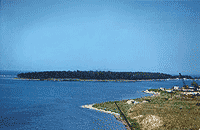 In the Porto Lagos lagoon one can visit the chapels of St Nicholas and Virgin Mary which are built on small islets.
In the Porto Lagos lagoon one can visit the chapels of St Nicholas and Virgin Mary which are built on small islets.
Lake Vistonida was formulated 5,000,000 years ago.It was named after the Vistons, a Thracian tribe living around. The area of the lake is 42 sq.km. The size of the lake decreases and increases alternately for almost 6 sq.km., depending on the season. The average depth of the lake is 2 – 2.5 m. (max. 3 m.).
The average depth of the lake is 2 – 2.5 m. (max. 3 m.).
It is a peculiarity of Vistonida Lake that there are great fluctuations in the salt content of its water. Thus, the water in the Northern part of the lake is brackish because of the influx of three rivers: Kosynthos, Kompsatos and Travos. On the contrary, the Southern part of the lake has salty water because of three canals connecting the lake with the sea.
All sorts of birds, in impressive numbers, dominate the area. There is also a great variety in vegetation and fauna. The silent (for human ears) world of fish amounts to 37 different species (including striped grey mullets and eels) in the lake. The animals living around are either carnivorous or herbivorous at various sizes. Wild cats, jackals and badgers seek refuge in the forests, the bushes and the delta of Kompsatos River, whereas, at a larger scale, there are wolves and roes.
 In the Porto Lagos lagoon one can visit the chapels of St Nicholas and Virgin Mary which are built on small islets.
In the Porto Lagos lagoon one can visit the chapels of St Nicholas and Virgin Mary which are built on small islets.Lake Vistonida was formulated 5,000,000 years ago.It was named after the Vistons, a Thracian tribe living around. The area of the lake is 42 sq.km. The size of the lake decreases and increases alternately for almost 6 sq.km., depending on the season.
 The average depth of the lake is 2 – 2.5 m. (max. 3 m.).
The average depth of the lake is 2 – 2.5 m. (max. 3 m.).It is a peculiarity of Vistonida Lake that there are great fluctuations in the salt content of its water. Thus, the water in the Northern part of the lake is brackish because of the influx of three rivers: Kosynthos, Kompsatos and Travos. On the contrary, the Southern part of the lake has salty water because of three canals connecting the lake with the sea.
All sorts of birds, in impressive numbers, dominate the area. There is also a great variety in vegetation and fauna. The silent (for human ears) world of fish amounts to 37 different species (including striped grey mullets and eels) in the lake. The animals living around are either carnivorous or herbivorous at various sizes. Wild cats, jackals and badgers seek refuge in the forests, the bushes and the delta of Kompsatos River, whereas, at a larger scale, there are wolves and roes.

